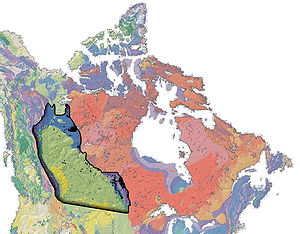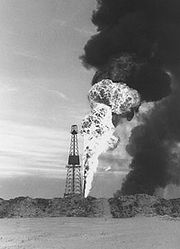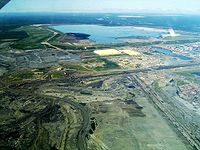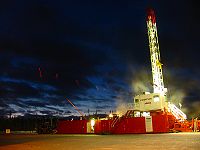
Western Canadian Sedimentary Basin
Encyclopedia

Sedimentary basin
The term sedimentary basin is used to refer to any geographical feature exhibiting subsidence and consequent infilling by sedimentation. As the sediments are buried, they are subjected to increasing pressure and begin the process of lithification...
underlying 1400000 square kilometres (540,543 sq mi) of Western Canada
Western Canada
Western Canada, also referred to as the Western provinces and commonly as the West, is a region of Canada that includes the four provinces west of the province of Ontario.- Provinces :...
including southwestern Manitoba
Manitoba
Manitoba is a Canadian prairie province with an area of . The province has over 110,000 lakes and has a largely continental climate because of its flat topography. Agriculture, mostly concentrated in the fertile southern and western parts of the province, is vital to the province's economy; other...
, southern Saskatchewan
Saskatchewan
Saskatchewan is a prairie province in Canada, which has an area of . Saskatchewan is bordered on the west by Alberta, on the north by the Northwest Territories, on the east by Manitoba, and on the south by the U.S. states of Montana and North Dakota....
, Alberta
Alberta
Alberta is a province of Canada. It had an estimated population of 3.7 million in 2010 making it the most populous of Canada's three prairie provinces...
, northeastern British Columbia
British Columbia
British Columbia is the westernmost of Canada's provinces and is known for its natural beauty, as reflected in its Latin motto, Splendor sine occasu . Its name was chosen by Queen Victoria in 1858...
and the southwest corner of the Northwest Territories
Northwest Territories
The Northwest Territories is a federal territory of Canada.Located in northern Canada, the territory borders Canada's two other territories, Yukon to the west and Nunavut to the east, and three provinces: British Columbia to the southwest, and Alberta and Saskatchewan to the south...
. It consists of a massive wedge of sedimentary rock
Sedimentary rock
Sedimentary rock are types of rock that are formed by the deposition of material at the Earth's surface and within bodies of water. Sedimentation is the collective name for processes that cause mineral and/or organic particles to settle and accumulate or minerals to precipitate from a solution....
extending from the Rocky Mountains
Rocky Mountains
The Rocky Mountains are a major mountain range in western North America. The Rocky Mountains stretch more than from the northernmost part of British Columbia, in western Canada, to New Mexico, in the southwestern United States...
in the west to the Canadian Shield
Canadian Shield
The Canadian Shield, also called the Laurentian Plateau, or Bouclier Canadien , is a vast geological shield covered by a thin layer of soil that forms the nucleus of the North American or Laurentia craton. It is an area mostly composed of igneous rock which relates to its long volcanic history...
in the east. This wedge is about 6 kilometres (3.7 mi) thick under the Rocky Mountains, but thins to zero at its eastern margins. The WCSB contains one of the world's largest reserves of petroleum
Petroleum
Petroleum or crude oil is a naturally occurring, flammable liquid consisting of a complex mixture of hydrocarbons of various molecular weights and other liquid organic compounds, that are found in geologic formations beneath the Earth's surface. Petroleum is recovered mostly through oil drilling...
and natural gas
Natural gas
Natural gas is a naturally occurring gas mixture consisting primarily of methane, typically with 0–20% higher hydrocarbons . It is found associated with other hydrocarbon fuel, in coal beds, as methane clathrates, and is an important fuel source and a major feedstock for fertilizers.Most natural...
and supplies much of the North America
North America
North America is a continent wholly within the Northern Hemisphere and almost wholly within the Western Hemisphere. It is also considered a northern subcontinent of the Americas...
n market, producing more than 16000000000 cubic feet (453,069,552 m³) per day of gas in 2000. It also has huge reserves of coal
Coal
Coal is a combustible black or brownish-black sedimentary rock usually occurring in rock strata in layers or veins called coal beds or coal seams. The harder forms, such as anthracite coal, can be regarded as metamorphic rock because of later exposure to elevated temperature and pressure...
. Of the provinces and territories within the WCSB, Alberta has most of the oil
Oil
An oil is any substance that is liquid at ambient temperatures and does not mix with water but may mix with other oils and organic solvents. This general definition includes vegetable oils, volatile essential oils, petrochemical oils, and synthetic oils....
and gas
Gas
Gas is one of the three classical states of matter . Near absolute zero, a substance exists as a solid. As heat is added to this substance it melts into a liquid at its melting point , boils into a gas at its boiling point, and if heated high enough would enter a plasma state in which the electrons...
reserves and almost all of the oil sands.
Conventional oil

Light crude oil
Light crude oil is liquid petroleum that has a low density and flows freely at room temperature. It has a low viscosity, low specific gravity and high API gravity due to the presence of a high proportion of light hydrocarbon fractions. It generally has a low wax content...
and heavy crude oil
Heavy crude oil
Heavy crude oil or extra heavy crude oil is any type of crude oil which does not flow easily. It is referred to as "heavy" because its density or specific gravity is higher than that of light crude oil. Heavy crude oil has been defined as any liquid petroleum with an API gravity less than 20°.Extra...
, each with different costs, prices, and development strategies. Conventional light oil is a mature industry with most of the recoverable oil reserves
Oil reserves
The total estimated amount of oil in an oil reservoir, including both producible and non-producible oil, is called oil in place. However, because of reservoir characteristics and limitations in petroleum extraction technologies, only a fraction of this oil can be brought to the surface, and it is...
already produced and production declining by three to four percent per year. Conventional heavy oil is also past its production peak with a future of long-term decline
Oil depletion
Oil depletion occurs in the second half of the production curve of an oil well, oil field, or the average of total world oil production. The Hubbert peak theory makes predictions of production rates based on prior discovery rates and anticipated production rates. Hubbert curves predict that the...
. Alberta, which contains most of the reserves, expects its light-medium crude oil production to decline by 42% from 2006 to 2016, while it expects heavy crude production to decrease by 35% over the same period. However, it also expects bitumen and synthetic crude oil from oil sands will considerably more than offset the decline in conventional crude oil and account for 87% of Alberta oil production by 2016.
For light oil, the petroleum industry
Petroleum industry
The petroleum industry includes the global processes of exploration, extraction, refining, transporting , and marketing petroleum products. The largest volume products of the industry are fuel oil and gasoline...
is searching for the remaining undiscovered pools, drilling infill oil well
Oil well
An oil well is a general term for any boring through the earth's surface that is designed to find and acquire petroleum oil hydrocarbons. Usually some natural gas is produced along with the oil. A well that is designed to produce mainly or only gas may be termed a gas well.-History:The earliest...
s, or redeveloping existing pools using enhanced oil recovery
Enhanced oil recovery
Enhanced Oil Recovery is a generic term for techniques for increasing the amount of crude oil that can be extracted from an oil field...
(EOR) techniques such as waterfloods, miscible floods, and carbon dioxide
Carbon dioxide
Carbon dioxide is a naturally occurring chemical compound composed of two oxygen atoms covalently bonded to a single carbon atom...
injection. Currently, only about 27 percent of light oil is recovered, leaving large opportunities for improvement.
For conventional heavy oil, the industry is exploring new zones in undrilled portions of the basin to find remaining undiscovered pools, or to apply EOR schemes such as water floods, thermal projects, and miscible floods such as the Vapour Extraction Process (VAPEX) technology. Only 15 percent of heavy oil is currently being recovered, leaving a large volume for future recovery.
Improved seismic and drill
Drill
A drill or drill motor is a tool fitted with a cutting tool attachment or driving tool attachment, usually a drill bit or driver bit, used for drilling holes in various materials or fastening various materials together with the use of fasteners. The attachment is gripped by a chuck at one end of...
ing technology, higher recoveries from existing pools through infill drilling, and efficient, cost-effective exploration and development of smaller pools are maintaining levels of conventional oil production in the Western Canadian Sedimentary Basin. As the basin matures, the resource triangle with few large pools at the top, and many small pools at the base is being economically pursued deeper into the smaller pool segment as a result of these efficiencies.
Oil sands

Athabasca Oil Sands
The Athabasca oil sands are large deposits of bitumen, or extremely heavy crude oil, located in northeastern Alberta, Canada - roughly centred on the boomtown of Fort McMurray...
, the Cold Lake
Cold Lake, Alberta
Cold Lake is a city in northeastern Alberta, Canada, named after the lake it is situated near.-Geography:The city is situated in Alberta's "Lakeland" district, 300 km northeast of Edmonton, near the Alberta-Saskatchewan provincial border. The area surrounding the city is sparsely populated,...
Oil Sands and the Peace River
Peace River (Canada)
The Peace River is a river in Canada that originates in the Rocky Mountains of northern British Columbia and flows to the northeast through northern Alberta. The Peace River flows into the Slave River, a tributary of the Mackenzie River. The Mackenzie is the 12th longest river in the world,...
Oil Sands, which contain initial oil-in-place reserves of 260 billion cubic metres (1.6 trillion barrels), an amount comparable to the total world reserves of conventional oil. According to the Alberta Energy and Utilities Board (EUB, now known as the Energy Resources Conservation Board, the ERCB), Alberta's oil sands areas contain an
ultimately recoverable crude bitumen resource of 50 billion cubic metres (315 billion barrels), with remaining established reserves of almost 28 billion cubic metres (174 billion barrels) at year-end 2004.
As a result of the oil price increases since 2003, the number of major mining
Mining
Mining is the extraction of valuable minerals or other geological materials from the earth, from an ore body, vein or seam. The term also includes the removal of soil. Materials recovered by mining include base metals, precious metals, iron, uranium, coal, diamonds, limestone, oil shale, rock...
, upgrading and thermal in-situ projects has grown to some 46 existing and proposed projects, encompassing 135 project expansion phases in various stages of execution. Estimates of capital expenditure
Capital expenditure
Capital expenditures are expenditures creating future benefits. A capital expenditure is incurred when a business spends money either to buy fixed assets or to add to the value of an existing fixed asset with a useful life extending beyond the taxable year...
s to construct all announced projects over the period 2006 to 2015 total $125 billion. This extremely high level of activity has caused a severe labor shortage
Labor shortage
In its narrowest definition, a labor shortage is an economic condition in which there are insufficient qualified candidates to fill the market-place demands for employment at any price...
in Alberta and driven unemployment
Unemployment
Unemployment , as defined by the International Labour Organization, occurs when people are without jobs and they have actively sought work within the past four weeks...
rates to their lowest level in history – the lowest of all 10 Canadian provinces and 50 U.S. states. This is the main factor limiting growth of oil sands production in the WCSB.
Natural gas

However, Canadian gas reserves represent less than one percent of world reserves and are rapidly becoming exhausted.
The majority of the large gas pools have been discovered and a significant portion of the discovered reserves has been produced. Production from the basin peaked in 2001 at around 16 Gcuft per day and is predicted by the National Energy Board
National Energy Board
The National Energy Board is an independent economic regulatory agency created in 1959 by the Government of Canada to oversee "international and inter-provincial aspects of the oil, gas and electric utility industries"...
to be likely to decline from that level. The overall decline rate increased from 13 percent per year in 1992 to 23 percent in 2002, which means 3.8 Gcuft/d of production must be replaced each year just to keep production constant. With the basin being largely explored and operators finding less gas with each new well, this seems improbable. New gas reserves in the WCSB will likely come from unconventional sources such as coalbed methane
Coalbed methane
Coalbed methane or Coal Bed Methane, coalbed gas or coal mine methane is a form of natural gas extracted from coal beds. In recent decades it has become an important source of energy in United States, Canada, and other countries...
(CBM).
The number of coalbed methane wells in Alberta more than doubled in 2005, to 7764 by the end of that year, producing nearly 0.5 Gcuft of gas per day. More than 95 percent of the CBM wells were completed in the Upper Cretaceous
Cretaceous
The Cretaceous , derived from the Latin "creta" , usually abbreviated K for its German translation Kreide , is a geologic period and system from circa to million years ago. In the geologic timescale, the Cretaceous follows the Jurassic period and is followed by the Paleogene period of the...
Horseshoe Canyon
Horseshoe Canyon Formation
The Horseshoe Canyon Formation is part of the Edmonton Group and is up to 230m in thickness. It is Late Campanian to Early Maastrichtian in age and is composed of mudstone, sandstone, and carbonaceous shales...
and Belly River formations, at typical depths of 300 feet (91.4 m) to 2400 feet (731.5 m). About 4 percent of the CBM wells are completed in the Lower Cretaceous Mannville formation, at depths of 2300 feet (701 m) to 4300 feet (1,310.6 m).
The Western Canada Sedimentary Basin will likely continue to be the main gas supply area in Canada for many years, however, declining production and the likelihood that much of the gas will be diverted to fuel new oil sands plants mean that the probability of there being sufficient surplus gas to meet projected U.S. demand is low, and the US will have to look elsewhere for future gas supplies.
Coal
The WCSB contains about 90 percent of Canada's usable coal resources. Their rank ranges from ligniteLignite
Lignite, often referred to as brown coal, or Rosebud coal by Northern Pacific Railroad,is a soft brown fuel with characteristics that put it somewhere between coal and peat...
to semianthracite. About 36 percent of the total estimated 71,000 megatonnes of usable coal is bituminous, including a high proportion of medium to low volatile coals. The low sulfur
Sulfur
Sulfur or sulphur is the chemical element with atomic number 16. In the periodic table it is represented by the symbol S. It is an abundant, multivalent non-metal. Under normal conditions, sulfur atoms form cyclic octatomic molecules with chemical formula S8. Elemental sulfur is a bright yellow...
content and acceptable ash levels of these bituminous coals make them attractive as coking
Coke (fuel)
Coke is the solid carbonaceous material derived from destructive distillation of low-ash, low-sulfur bituminous coal. Cokes from coal are grey, hard, and porous. While coke can be formed naturally, the commonly used form is man-made.- History :...
feedstocks, and large quantities are mined for that purpose. However, the lack of heavy industry in Western Canada means that only a limited amount of this coal is consumed in Canada, and most is exported to Japan, Korea and other countries. The lower rank coals are used mainly for electricity generation, where the existence of shallow coal seams with little overburden make strip-mining and reclamation
Mine reclamation
Mine reclamation is the process of creating useful landscapes that meet a variety of goals, typically creating productive ecosystems from mined land...
easy, and low sulfur levels reduce the environmental impact
Environmental impact assessment
An environmental impact assessment is an assessment of the possible positive or negative impact that a proposed project may have on the environment, together consisting of the natural, social and economic aspects....
of their use.
See also
- Oil wellOil wellAn oil well is a general term for any boring through the earth's surface that is designed to find and acquire petroleum oil hydrocarbons. Usually some natural gas is produced along with the oil. A well that is designed to produce mainly or only gas may be termed a gas well.-History:The earliest...
- OPECOPECOPEC is an intergovernmental organization of twelve developing countries made up of Algeria, Angola, Ecuador, Iran, Iraq, Kuwait, Libya, Nigeria, Qatar, Saudi Arabia, the United Arab Emirates, and Venezuela. OPEC has maintained its headquarters in Vienna since 1965, and hosts regular meetings...
- List of oil-producing states
- History of the petroleum industry in CanadaHistory of the petroleum industry in CanadaThe Canadian petroleum industry arose in parallel with that of the United States. Because of Canada's unique geography, geology, resources and patterns of settlement, however, it developed in different ways...
External links
- Alberta Department of Energy (ADOE)
- Energy Resources Conservation Board (ERCB)
- Alberta Geological Survey (AGS)
- Alberta Research Council (ARC)
- Canadian Gas Potential Committee (CGPC)
- Canadian Society of Petroleum Geologists (CSPG)
- Geological Survey of Canada (GSC)
- National Energy Board of Canada (NEB)
- Saskatchewan Industry and Resources (SIR)
- Western Canadian Sedimentary Basin Home to Significant Hydrocarbon Resources

